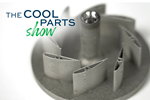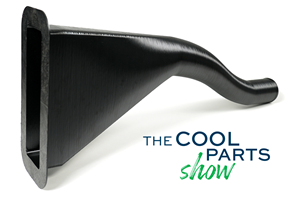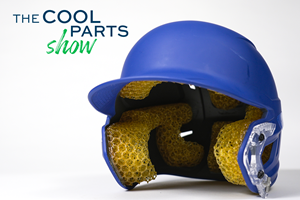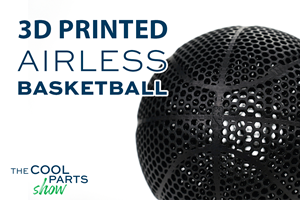On The Cool Parts Show, we talk about the design freedom of 3D printing, including the freedom to rapidly produce design iterations to test different component geometries. But it’s important to stress: Additive manufacturing involves more than just 3D printing, and that’s true even when it comes to prototyping. In a recent episode about swirlers for gas turbines, Stephanie Hendrixson and I heard from Penn State additive manufacturing students working with gas turbine researcher Dr. Jacqueline O’Connor about the 3D printing choices they made in the design of prototype swirlers. Other important work was also necessary to explore and validate the swirler designs, so now we turn to those steps. In this episode: the additive manufacturing work in addition to the 3D printing. | This episode of The Cool Parts Show brought to you by Carpenter Additive
The Cool Parts Show is a video series from Additive Manufacturing Media that explores the what, how and why of unusual 3D printed parts. Watch more here.
Have a cool part to share? Email us.
Related Resources
- The Cool Parts Show #42 — 3D printed swirlers for better gas turbine flames
- Additive manufacturing and 3D printing are two different things
- Penn State Center for Gas Turbine Research, Education, and Outreach, which funded this project and is directed by Dr. Jacqueline O’Connor
Transcript
Pete Zelinski
I'm Pete.
Stephanie Hendrixson
I'm Stephanie.
Pete Zelinski
Welcome to a quick bonus episode of The Cool Parts Show.
Stephanie Hendrixson
That's right, we recently did an episode on these 3D printed swirlers. These are devices that mix and combust fuel inside a turbine. And the designs that we have here were all created by students at Penn State University. In that original episode, we mostly talked about the design in the 3D printing. If you want to watch the whole thing, you can find the link to it in the description. But there were some other steps, some other things that needed to happen to these swirlers to prepare them for their ultimate flame test.
Pete Zelinski
The flame test, so we met some other students who were involved in some of the prep necessary to evaluate these parts. We wanted you to meet them, but also, they illustrate a really important point about additive manufacturing, which is additive manufacturing is more than 3D printing. There's always more going on than that. Even in cases like this, where the work right now is proving out the design, advancing toward a more optimal design. Even to test an engineered design effectively, there are important steps that go beyond the 3D printing. So here's an example of that. Here's a picture of the additional work that might be involved.
Stephanie Hendrixson
So first up, we'll hear from Willem Groeneveld-Meijer. He is a first-year graduate student in mechanical engineering and he worked on machining the central bore in these swirlers, which was not an easy task because these are made out of Inconel.
Willem Groeneveld-Meijer
So the 3D printed parts that came to us were, they were printed in 718 Inconel. When we received them, they had no center bore, there was no through-hole, we were tasked with modifying them in order to allow them to work in our testing rig and to fit thermocouples into the parts. The most important thermocouple is the one that sits right at the top plane where the flame sits. Basically, the only way to get that into that position was to run it through the center of the swirler and the center of body and swirler. So to achieve that, we had to take this to the machine shop, I bored through this part and I also added a thread on the top.
Pete Zelinski
Next up Kyle McFerran. He is a senior studying mechanical engineering at Penn State and the work that he did had to do with placing thermocouples accurately to gather the data needed to evaluate the effectiveness of a swirler design.
Kyle McFerran
So at the beginning of summer, Dr. O'Connor came to me and she wanted to get the temperature at the tip of the center body which can be seen here actually. And this is where the flame sits whenever actually testing the rig. So she wanted that temperature just to see how hot it gets up there and then also wanted a temperature inside of the swirler itself. And this is to account for flashback. And this is whenever the flame comes back into the test rig, it's whenever the flame speed is faster than the airflow coming up. Obviously, this is undesirable. So I was tasked with putting thermocouples inside of the swirlers so that we can read these temperatures if there's a drastic change, and we know flashbacks occurred, and we know to stop running the test and figure out where the problem is. So my main work was, I did a lot of putting swirler designs inside the air foils here, and inside there's a little pocket where I'll insert the thermocouple into, and then it will wrap around these diagonal rods and then the wires will come out through the bottom, there's little holes. Then I'll go at the bottom of the test rig through the motor. And then also there will be a thermocouple going through the middle of the center body. It will be a quarter of an inch below the tip. So that's how we'll get the center body temperature. And that's going to be done with this thermocouple probe right here.
Stephanie Hendrixson
So those were some of the hardware challenges associated with these, but there was also a software component as well. Abhi Vajjala, who is a fourth-year mechanical engineering student worked on simulating the computational fluid dynamics so that when these do go into the flame test, we'll have something to compare it to, to understand the performance of how a typical swirler works.
Abhi Vajjala
Dr. O'Connor asked me to join this REU program. And what she mainly wanted me to do is sort of run the whole CFD operation, lead through like sort of the simulation of the whole model, running it through gathering data, working through it so that way I can send off the data to her and verify that what's happening in simulation is what's gonna be happening when they're running the experiments once they get all their additive manufacturing parts into the swirler and run the machine. So when I got the whole problem, they sent me the CAD model of the whole combustor, of the whole device and I kind of stripped down the parts. Mainly focus on like the swirler or the nozzle. The program that I use for that summer was Star CCM+, which is pretty much a program that they use to analyze CFD, and run post processing.
Pete Zelinski
For the episode about the 3D printing of these swirlers, find the link in the show description. For links to all of our episodes, go to TheCoolPartsShow.com
Stephanie Hendrixson
Thanks for watching.
Related Content
Aircraft Ducts 3D Printed in Composite Instead of Metal: The Cool Parts Show #68
Eaton’s new reinforced PEKK, tailored to aircraft applications, provides a cheaper and faster way to make ducts compared to formed aluminum.
Read More3D Printed Lattices Replace Foam for Customized Helmet Padding: The Cool Parts Show #62
“Digital materials” resulting from engineered flexible polymer structures made through additive manufacturing are tunable to the application and can be tailored to the head of the wearer.
Read MoreThis Drone Bird with 3D Printed Parts Mimics a Peregrine Falcon: The Cool Parts Show #66
The Drone Bird Company has developed aircraft that mimic birds of prey to scare off problem birds. The drones feature 3D printed fuselages made by Parts on Demand from ALM materials.
Read MoreAirless Basketball Shows Promise of 3D Printed Lattices: The Cool Parts Show Bonus
Successfully matching the performance of a standard basketball demonstrates the control possible over the mechanical properties of digital materials.
Read MoreRead Next
Additive Manufacturing and 3D Printing Are Two Different Things
And as AM continues to advance, the differences are becoming more pronounced and more important.
Read More3D Printing for Better Flame From a Gas Turbine Swirler: The Cool Parts Show #42
A Penn State gas turbine researcher turns to additive manufacturing graduate students to help face the challenge of swirler optimization.
Read MorePostprocessing Steps and Costs for Metal 3D Printing
When your metal part is done 3D printing, you just pull it out of the machine and start using it, right? Not exactly.
Read More



















